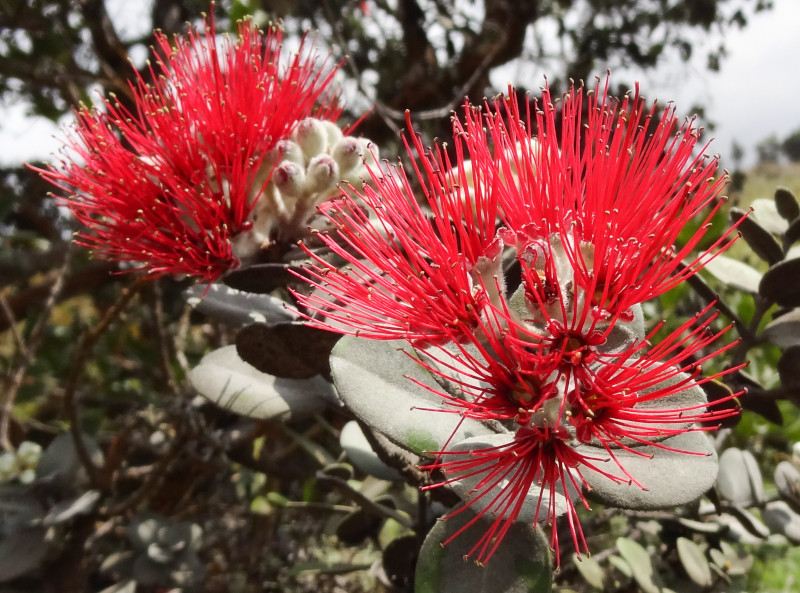
Lehua Tree Facts
- The short term of Lehua Tree serves as both the english language name and the most frequently used common name for this amazing plant. Yet, its original moniker, in the native language of the local Indigenous Peoples, is that of ōhiʻa lehua.
- Inside scientific circles, however, it’s perhaps better known by its technical appellation. Sadly, though, that’s a label far too difficult for most laypeople to pronounce properly. That’s because it holds the formal epithet of Metrosideros polymorpha.
- The stunning flora received that tag due to the efforts of Charles Gaudichaud-Beaupré. This noted French botanist accomplished the original recognition of it as a separate and distinct species. He managed that noteworthy deed in the early 19th century.
- Unfortunately, the Lehua Tree now finds itself in a somewhat perilous situation. Though still abundant, it’s dealing with both invasive species and the presence of a mysterious fungal threat. The IUCN now lists this marvelous plant as Vulnerable.
- In addition to these dangers, the beautiful and distinctive Eudicot also faces other threats to its continued existence as a species. Like other forms of life on earth, most of these stem from the actions of man. They include habitat loss and climate change.
Related Articles
Lehua Tree Physical Description
The stunning Lehua Tree not only captivate those fortunate enought to view it, it also frequently startles them That’s due to the extreme variability of the nature of the intriguing plant. This marvel of botanical evolution varies in size from a low shrub to a towering tree.
In its shrub form, this wonder of the natural world rarely exceeds 40 ft (12.2 m ) in height. The width of such examples, however, typically measures an incredible 30 ft (9.1 m). These dimensions still make for a gorgeous hedge of truly astounding proportions.
When it develops as a tree, though, it’s understandably much more vertical and slender in its growth. This version generally ranges from 66 – 82 ft (20 – 25 m) in height. Exceptional specimens, however, sometimes achieve heights of up to as much as 100 ft (30 m).
In either version, the bark of the species also merits attention. Among younger plants, this part usually presents a smooth texture, and a light gray in color. But, as the flora ages, this covering typically darkens slightly, and becomes much rougher and often scaly.
The leaves of the Lehua Tree generally develop as oval in shape. Like the tree it forms on, this foliage also tends to vary in size. This ranges from roughly 0.5 – 3 in (1.3 – 7.6 cm) in length, and 0.5 – 2.25 in (1.3 – 5.7 cm) in width. They’re also usually dark green and leathery.
Yet, it’s the incredible flowers of the Angiosperm that receive the most interest. These actually represent a large mass of upright stamens. In color, these most often display a brilliant red. Other colors do occur, though, including orange, yellow, salmon, and even pink.
- Kingdom: Plantae
- Phylum: Tracheophyta
- Class: Eudicots
- Order: Myrtales
- Family: Myrtaceae
- Genus: Metrosideros
- Species: M. polymorpha
Lehua Tree Distribution, Habitat, and Ecology
The astonishing Lehua Tree evolved as endemic to a highly restricted and isolated section of the surface of the earth. Given its nature, though, the location of that zone of habitation comes as no surprise to many of those who learn of it. It only lives on certain islands.
More precisely, it developed as native to an island chain situated in the North Pacific Ocean. Out of the eight major islands comprising the Hawaiian Islands, it occurs on six of them. Ni’ihau and Kaho’olawe form the sole exceptions. It’s unknown if it ever lived elsewhere.
Within that limited range, however, the remarkable Eudicot displays an impressive flexibility regarding its choice of habitat. That’s because the lovely marvel of Nature resides naturally in areas with a wide range of rainfall amounts, temperatures, and soil conditions.
These regions of habitation include such diverse types as high shrublands and both dry and moist forests. It also appears at altitudes ranging sea level to elevations of as much as 8,200 ft (2,500 m). There, the adaptive tree further serves as a common part of cloud forests.
The fabulous Lehua Tree achieves pollination via the actions of a large variety of locally prevalent insect species. Subsequent to this, the tree typically flowers in early spring. Yet, the amazing product of evolution also has the ability to propogate vegetatively, too.
In any of the ecosystems it grows in, though, this flora plays important roles. Its confines frequently provde importatn havens for native birds, some of whom are now endangered. It’s also the first large plant to appear after lava flows, providing watershed protection.
Species Sharing Its Range
Check out our other articles on 4 Stunning Bering Sea Species, Eastern Gray Squirrel, Le Morne Brabant, Scarce Swallowtail, Spiny Butterfly Ray, Great Potoo, Indian Bullfrog, Jamaican Iguana
